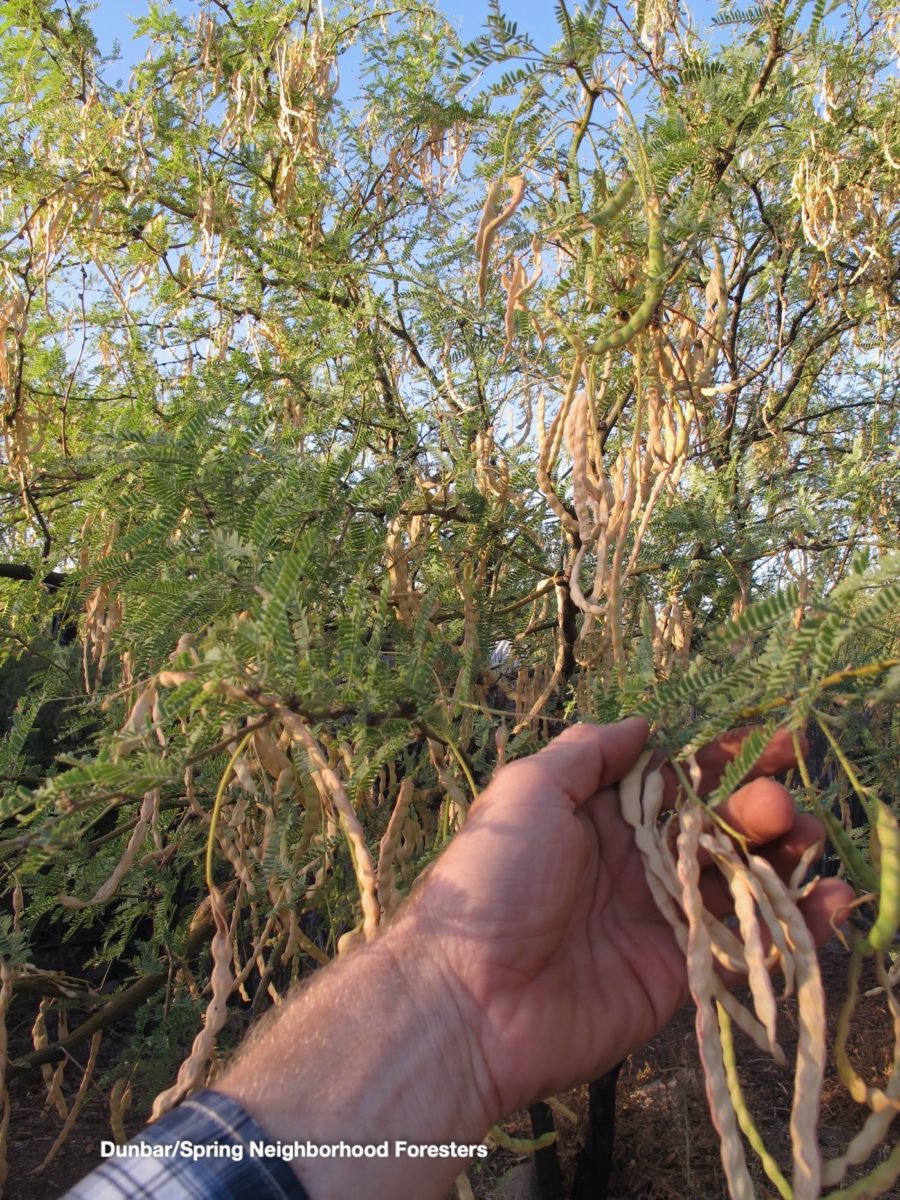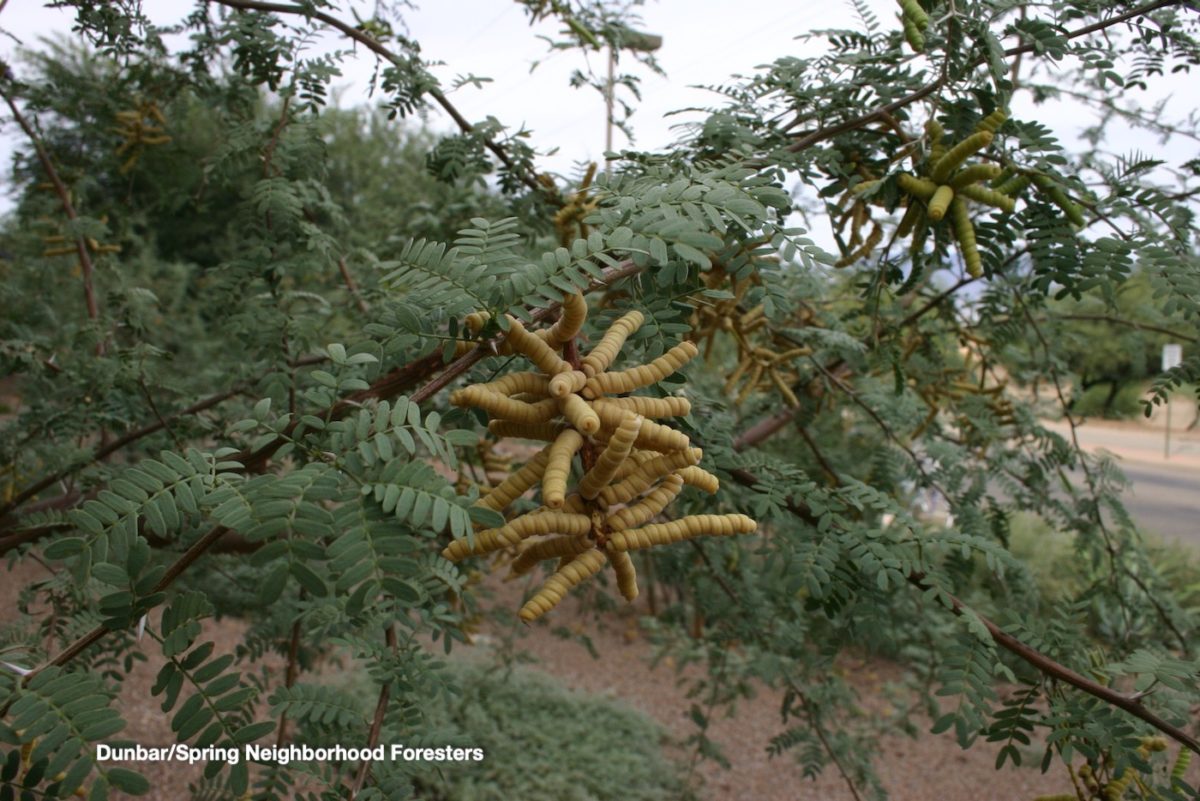
Photo: Brad Lancaster
Compiled by Brad Lancaster
Prosopis velutina – Velvet Mesquite, Mezquite
(Leguminosae – Pea Family):
Spanish name(s): mezquite, algarobba;
Tohono and Hia c-ed O’odham name: kuiAkimel
O’odham name: kui chepelk
Yeome name: hu’upa
Characteristics
This is the most common native mesquite around Tucson. Blooms (yellow) April – May (blooms again in Aug.). Allergenic – 2. Seed pod harvest June – September with 10 sq. ft. of tree yielding up to 13 bushels or more of pods (Podems and Bortz, 1975). But in low desert it is best to harvest ripe mesquite pods BEFORE the rains. Found in elevation range of 1,000 – 5,000′. Multi-trunked tree with shaggy bark, grey-green fern-like leaves and branches that curve with loads of character. Younger portions of tree have some thorns. Grows up to 30′. Fast growth. Long lived. Prefers full sun. Cold hardy to 5˚ F. Found in flood plains and along arroyos. Nitrogen – fixing (Turner, et al 1995). Pioneer. Winter deciduous.
Wildlife it supports
Doves, quail, and ravens eat the seedpods; big horn sheep eat the seedpods; rabbits, coyote, ground squirrel, k-rats, antelope, skunk, wolf, eat the seeds, leaves, and bark; twigs and foliage – deer; flowers attracts 60 species of native bees, along with beneficial wasps and butterflies (Bowers, 1993); a nectar and larval plant for butterflies; excellent bee fodder; nesting site for white-winged and morning doves; host plant for mistletoe which attracts birds such as the phainopepla.
Edible
The Gila Pima have utilized the pods as a major food staple in the form of flour, porridge, drinks, and cakes (Rea, 1997); the Cahuilla would keep a basin, containing half-crushed mesquite pods filled with water, for all to quench their thirst in the hot summer months (Bean and Saubel, 1972); I boil mesquite pods in a volume of water twice the volume of mesquite beans along with a cinammon stick (optional) for two hours, let it sit overnight, strain out the solids, then I’ve got one tasty drink which I usually serve chilled.
The mesquite bean provides protein, carbohydrates, and calcium with four tablespoons of mesquite meal providing 70 calories (Niethammer, 1974); the ground pods can be used for foods ranging from crackers to breads to mousse (Niethammer, 1987), (Niethammer, 1974); the tree is a source of gum arabic-like gum (Facciola, 1998); dry pods ground and fermented made a food similar to old English mead (Curtin, 1997); cooked pods can produce molasses (Moore, 1989); catkins have been eaten as a starvation food (Rea, 1997); blossoms were picked by the Cahuilla, pit roasted, and then squeezed into balls ready for eating. Prepared blossoms were stored in pottery vessels and cooked as needed in boiling water. Blossoms also used to make a tea (Bean and Saubel, 1972); sap resin used as candy (Rea, 1997); sap was collected in dry months before the monsoon rains and ground to make a candy (personal communication with Cipriano 7/1/2000); pods can be used to make atole and jelly (English, 1981); good food for diabetcis (Nabhan, 1991). I love to harvest the dry sap resin from good tasting trees (it seems the trees that have good-tasting pods also have good-tasting sap), which I then use as a throat lozenge or cough drop—I find this far more effective than commercial lozenges.
Cicadas and an unidentified grasshopper-like insect were gathered in mesquite groves and roasted whole by the Cahuilla for a tasty delicacy (Bean and Saubel, 1972). Medicinal (Felger and Moser, 1985), (Russell, 1975), (Curtin, 1997), (Kay, 1996), (Moore, 1989), (Rea, 1997), (Bigfoot), (Niethammer, 1974), (Bean and Saubel, 1972).
Other uses
Wonderful garden tree (Nabhan, 1985) (not only does it fertilize the soil and protect what is under its canopy, but its leafing out in spring is a sign that the frosts are over until fall); nitrogen-rich leaf drop can be heavy – which is great for building soil; wood used for building and crafts; wood is used to smoke food, but a handful of dry seed pods thrown in a fire can be used in place of the mesquite wood to obtain the same smokey flavor without the loss of good mesquite wood; wood used to make plows and smaller limbs used to make bows (Bean and Saubel, 1972); root fiber makes cordage (Felger and Moser, 1985); bark is pounded, rubbed and pulled to make soft fiber for weaving nets and skirts (Nabhan and West, 1998); inner bark makes good basketry material (Kearney and Peebles, 1951); rubbed and pounded bark made into baby diapers (Cheatham, 1998); slender stems used to make cradleboard frames (Felger and Moser, 1985); bark and pitch used to make black dye and paint for ceramics and hair (Felger and Moser, 1985), (Russell, 1975), (Rea, 1997); wood used for construction, harpoon shafts, fine woodwork, fire drills, fish hooks, violin bows, and pestles (Felger and Moser, 1985); gum from bark used to make glue (Kearney and Peebles, 1951); mesquite groves are indicators of ground water (Bean and Saubel, 1972); seed pods used as livestock fodder (Russell, 1975), (Podems, 1975); goats and cattle also eat the leaves and bark; chickens like the seed and ground pods; great honey plant (Kearney and Peebles, 1951). Wonderful nurse plant.
Caution
Ingestion of large amounts of mesquite by cattle (when it is the exclusive source of fodder) over an extended period of time results in rumen stasis and impaction with associated symptoms, and eventually death (Kingsbury, 1964).
Guild/companion plants
Canyon hackberry, velvet ash, atriplex canenscens, panicgrass, six-weeks grama, fringed amaranth, jojoba, desert honeysuckle, desert hackberry, condalia, greythorn, wolfberry, mormon tea, hopbush, barberry, Texas mulberry, barrel, Christmas cholla, snapdragon vine, tumamoc globeberry, chuparosa.
Water needs
LW 1-2 after establishment
LW = low water 10 – 20 inches of water per year
(“1” = no supplemental irrigation, “2” = once a month irrigation in growing season

Photo: Brad Lancaster
Prosopis pubenscens – Screwbean mesquite, Tornillo
(Leguminosae-Pea Family):
Characteristics
Blooms yellow (April – summer). Allergenic 2. Found at 4,000′ and below. Large shrub to small, multi-trunked tree with medium green, fern-like leaves and shaggy bark. Thorns on younger growth. Grows 15-20′ tall. Moderate growth rate. Moderate lifespan. Found in flood plains and along dry washes or low desert streams. Prefers full sun. Cold hardy to 0 degrees F.
Edible
Pods can be eaten raw, roasted, ground (Russell, 1975), or made into an alcoholic drink (Facciola, 1998); boiled pods can make a fair molasses (Moore, 1989), (Curtin, 1997), (Facciola, 1998); pods soaked, dried, and pounded to make flour were once a major staple food among the Gila Pima (Rea, 1997); good food for diabetics (Nabhan, 1991). I find the screwbean pods easier to process by hand (mano y metate) than the other mesquites due to the smaller, softer seeds and have often used them with schoolchildren when teaching them how to make primitive mesquite cakes. Unlike the other mesquite pods the screwbean pods can be roughly ground seed, pod, and all (the seeds don’t need to be seperated) by hand in a stone mortar into a course flour. To make the mesquite cakes, the flour is mixed in hand with water and patted into a small, round biscuit shape. The biscuits are dried in the sun and can then be eaten any time as is or mixed with liquid to soften them up. The kids love it and so do I! I boil mesquite pods in a volume of water twice the volume of mesquite beans along with a cinammon stick (optional) for two hours, let it sit overnight, strain out the solids, then I’ve got one tasty drink which I usually serve chilled!
Medicinal (Curtin, 1997), (Moore, 1989), (Russell, 1975), (Rea, 1997).
Other uses
Fruit and leaves as browse for livestock (Kearney and Peebles, 1951)
branches make good fuel and fence posts (Curtin, 1997), (Rea, 1997)
bark used for basketry (Rea, 1997); root fiber used for cordage (Cheatham, 1998)
wood used for bows and cradleboard frames (Rea, 1997)
wood used for tool handles (Kearney and Peebles, 1951)
windbreak (Mielke, 1993)
gum used as an adhesive (Cheatham, 1998). Deciduous. LW(2).
Preferred Mesquite Trees to Plant
Whatever mesquite is native to your area.
In Tucson, we recommend the native Velvet Mesquite (Prosopis velutina). This is a very hardy, low-water-use, fast-growing tree. Unlike the non-native Chilean or South American hybrids, this indigenous tree rarely blows over in winds and very seldomly heaves adjacent sidewalks or foundations. In addition, it produces harvestable pods both in the early summer and late summer.
An additional recommended mesquite for Tucson is the Screwbean Mesquite (Prosopis pubescens). While not as large, nor as hardy or drought-tolerant, as the Velvet Mesquite, the Screwbean is fast-growing and produces an unusual and very tasty screwbean pod. This tree used to be far more common growing along the Santa Cruz in the days of perennial water flow.
In Southeastern Arizona, the Honey Mesquite (Prosopis glandulosa) is native.
These native mesquites are superior to non-native mesquites in terms of providing wildlife habitat. Native plants attract more native wildlife, since the two have co-evolved over millenia.
